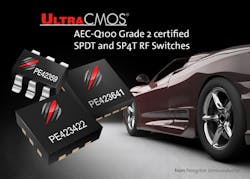Applications for high-frequency components, such as switches, once meant systems in the home or in a wireless-communications basestation outside the home. But wireless components are increasingly taking to the road, as in automotive-electronics applications. In that vein, a pair of broadband, high-speed switches from Peregrine Semiconductor Corp. were developed to meet Grade 2 AEC-Q100 requirements for such applications ranging from -40 to +105°C.
This file type includes high resolution graphics and schematics when applicable.
Model PE423422 is a single-pole, double-throw (SPDT) switch with frequency range of 100 MHz to 6 GHz, while model PE423641 is a single-pole, four-throw (SP4T) switch with bandwidth of 50 MHz to 3 GHz. These high-speed, low-cost RF/microwave switches join the firm’s earlier model PE42359 SPDT switch (10 MHz to 3 GHz) in meeting Grade 2 AEC-Q100 automotive environmental requirements. And with their excellent electrostatic-discharge (ESD) ratings, they’re well-suited for automotive-infotainment and traffic-safety applications.
The three automotive switches (see figure) draw upon Peregrine’s UltraCMOS semiconductor process, a patented variation of silicon-on-insulator (SOI) technology using a sapphire substrate. UltraCMOS was developed to provide the high-frequency performance levels of gallium-arsenide (GaAs) semiconductor technology and high level of integration plus low cost of silicon CMOS technology. In addition, the PE423422 and PE423641 switches benefit from the company’s HaRP technology for enhanced linearity and harmonic performance through their wide frequency ranges.
The earlier introduced 10-MHz to 3-GHz PE42359 SPDT switch features typical low insertion loss of 0.35 dB at 1 GHz and 0.5 dB at 2 GHz. Isolation between ports is typically 35 dB to 1 GHz and 21 dB to 2 GHz. This SPDT switch, with a typical 1-dB compression point of +33.35 dBm, runs on supply voltages as low as +1.8 V dc and achieves 2-μs typical switching time, from 50% control to 10% or 90% RF signal. The PE42359 squeezes into a six-lead SC-70 package and features high ESD tolerance of 2 kV per the human body model (HBM).
The new model PE423422 SPDT switch operates from 100 MHz to 6 GHz with low insertion loss of 0.25 dB to 1 GHz, 0.40 dB to 3 GHz, 0.65 dB to 5 GHz, and 0.90 dB to 6 GHz. The isolation between ports is typically 41 dB to 1 GHz, 28 dB to 3 GHz, 20 dB to 5 GHz, and 16 dB to 6 GHz. The switch, which runs on a +2.3- to +5.5-V dc supply range, offers 2-μs switching speed, from a 50% control signal to a 10% or 90% RF signal level. It handles input signals to +34 dBm with typical input compression of only 0.1 dB. The switch comes in a 12-lead 2- × 2-mm QFN package and is rated for ESD of 1 kV per the HBM on all pins.
The new SP4T model PE423641 controls 50 MHz to 3 GHz with low insertion loss of 0.5 dB to 1 GHz and 0.65 dB to 2.2 GHz. It achieves isolation between ports of 32 dB to 1 GHz and 25 dB to 2.2 GHz. The typical switching speed from 50% control to 10%/90% RF signal is 1 μs. The switch, which operates on +1.8- and +2.75-V dc levels, offers a +37-dBm typical input 0.1-dB compression point. It’s supplied in a 16-lead 3- × 3-mm QFN package.
These three low-cost, RoHS-compliant packaged switches are control components that, unlike conventional CMOS devices, will be immune to latch-up conditions. In addition, blocking capacitors aren’t required on the RF ports if dc isn’t present. Although all three switches feature high ESD ratings, they should be handled with the precautions used for any ESD-sensitive device. With their wide frequency and temperature ranges, they should fit more than a few emerging automotive applications.
Peregrine Semiconductor Corp., 9380 Carroll Park Dr., San Diego, CA 92121; (858) 731-9400, FAX: (858) 731-9499
This file type includes high resolution graphics and schematics when applicable.
About the Author
Jack Browne
Technical Contributor
Jack Browne, Technical Contributor, has worked in technical publishing for over 30 years. He managed the content and production of three technical journals while at the American Institute of Physics, including Medical Physics and the Journal of Vacuum Science & Technology. He has been a Publisher and Editor for Penton Media, started the firm’s Wireless Symposium & Exhibition trade show in 1993, and currently serves as Technical Contributor for that company's Microwaves & RF magazine. Browne, who holds a BS in Mathematics from City College of New York and BA degrees in English and Philosophy from Fordham University, is a member of the IEEE.

